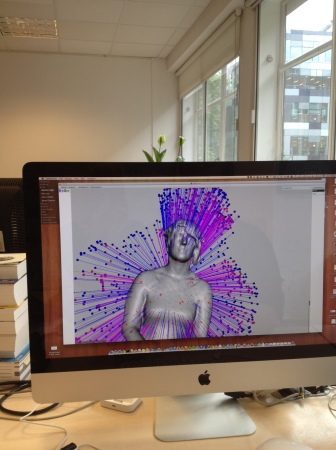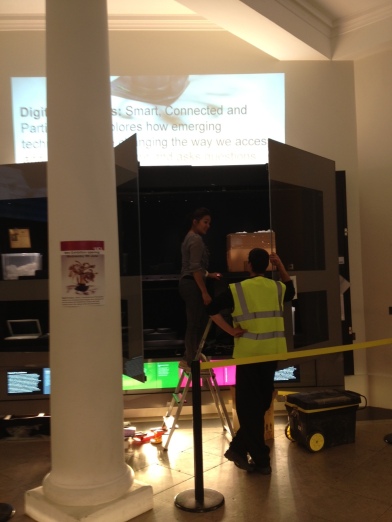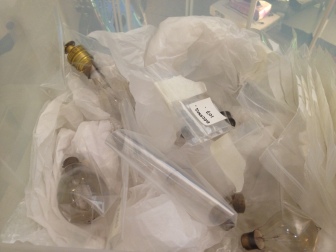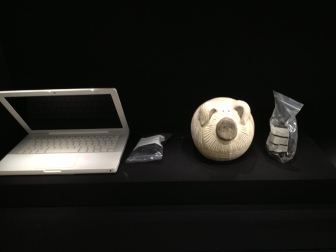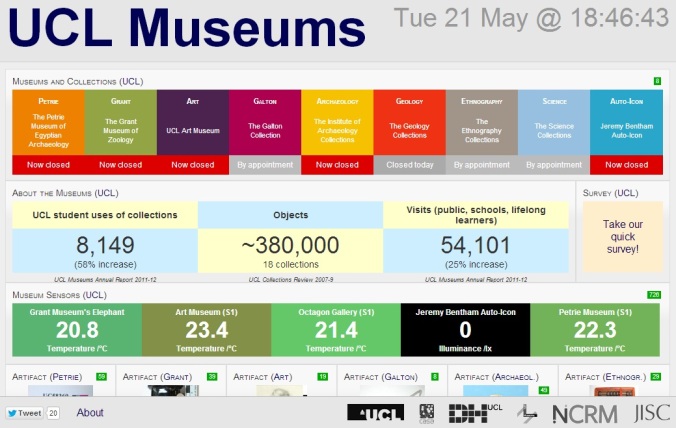 day 2 of installation was a bit more stressful than the first. I think the realisation has hit that this is actually my exhibition. A physical representation of things, ideas and research that I’m interested in and fascinated by. The objects being installed range from Luna imagery to a drawer full of tropical flies. And they all look stunning. But I’m still really worried about my labels. Lots of people stopped to have a look today and asked questions about what the objects were and they had a personal interpretation filled with plenty of Claire’s brand of enthusiasm for each object. The only problem being I don’t seem to be able to distil my enthusiasm into label form. It’s the age old problem in museums. It would be great to have an enthusiastic knowledgeable curator next to each object, providing their unique interpretation to the visitor. But that just isn’t viable.
day 2 of installation was a bit more stressful than the first. I think the realisation has hit that this is actually my exhibition. A physical representation of things, ideas and research that I’m interested in and fascinated by. The objects being installed range from Luna imagery to a drawer full of tropical flies. And they all look stunning. But I’m still really worried about my labels. Lots of people stopped to have a look today and asked questions about what the objects were and they had a personal interpretation filled with plenty of Claire’s brand of enthusiasm for each object. The only problem being I don’t seem to be able to distil my enthusiasm into label form. It’s the age old problem in museums. It would be great to have an enthusiastic knowledgeable curator next to each object, providing their unique interpretation to the visitor. But that just isn’t viable.
Author: claireyross
Creating a mini me: Playing with 3D printing
As part of the Digital Frontiers exhibition I have been experimenting a bit with 3D printing. This is why working in a university is brilliant as there is so many clever people and bits of kit about who will let you have a bit of a play.
3D tech is becoming quite big in museum discussions right now, and many museums are looking to embed 3D features permanently into their museum services but there are a few challenges to do this. Check out Andrew Lewis’ from the V&A’s post about How ready is 3D for delivering museum services? And my post from bits to blogs about Crapjects.
Because 3D is emerging and is turning out to be a playfully disruptive technology I felt it was important to experiment with just what could be done relatively quickly with 3D tech for an exhibition.
A couple of months ago I had myself scanned quickly by Jan Boehm and John Hindmarch from UCL Engineering, Virtual Environments, Imaging & Visualisation which was then printed out with Andy Hudson Smith’s (CASA) 3D printer and it produced this prototype:
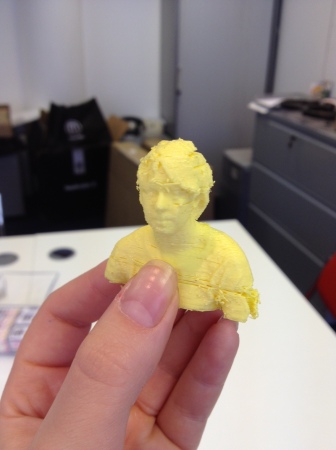 Last night Steve Gray and I had another play, this time creating an object model mesh with a Kinect. We used a Kinect and the software ReconstructMe.
Last night Steve Gray and I had another play, this time creating an object model mesh with a Kinect. We used a Kinect and the software ReconstructMe.
Microsoft’s Kinect is an awesome piece of tech. Instead of game play you can use its Infrared sensors to do depth of field scanning! We were trying to work out a re-usable workflow, so we could then scan everybody! We started with a desk drawer and moving the kinect around but that didn’t really cut it. Eventually with a bit of tinkering we has success with an office swivel chair is to allow the object (aka me) to revolve slowly in front of the Kinect!
The scans produced are not faultless, but they are really very good for such simple and cheap kit. We (I say we, but actually Steve) cleaned up the scan using free tools. Here is a scan of myself showing the problem areas. This is in MeshMixer:
The final result was using a mix of MeshMixer and MeshLabs and NetFabb Basic to fix gaps in the models.
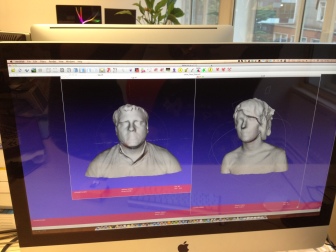
And if you so wish, you can download and print either Steve or me, or both of us out! We added ourselves to thingyverse. Now everyone can have a mini Claire! since last night there’s already been 12 downloads of us! weird!
Digital Frontiers: Installation Day 1
Over the past 6 months, I have been pondering the multitude of objects within UCL Museums and Collections in order to create an exhibition which focuses on the impact digital technology is having/had/will have on culture and society.
Here’s the official blurb:
Digital Frontiers: Smart, Connected and Participatory explores how emerging technologies are changing the way we access and experience culture and asks questions about the nature of art and technology. New digital applications are shaping our daily lives; the way we live, work, and study, but is digital technology really new? Digital Frontiers unravels digital culture, illustrates the power of emerging applications and poses questions about technology and culture in the past and in the present.
It’s been hard work and brilliant fun in equal measure.
Selecting objects was great. At first I was getting drawn to the most unusual, weird, gorgeous, amazing objects, but it soon became clear that I was creating a Claire’s Cabinet of Curiosities. Unfortunately that was not the theme of the exhibition, so with the help of some of the fantastic UCL collection curators I began an incredibly steep learning curve of researching individual objects, themes and narratives. This was fascinating but tough at the same time particularly when it came to the Science collections. I love scientific objects and research, but I’m not a scientist, so lots of concepts were completely lost on me. So many awesome objects, but for the most part I didn’t have a clue what they were for! Throughout the process I have become obsessed with Light Bulbs and early calculators! We got there in the end though and yesterday was the 1 day of Installation in the Octagon Gallery!
We have started with the Historical Science collections, as most of the exhibition objects are scientific, focusing on smart and connected technology. I have to give a massive thank you to Nick Booth, the Geology & Historical Sciences curator, who has put up with endless emails, face to face meetings, and more emails mostly about me getting confused between light bulbs and Thermionic Valves. Also massive thanks to Susie Chan, exhibition officer extraordinaire, for keeping the exhibition planning on track, and for not letting me get distracted. Susie, who not only has fashion sense to die for and can run crazy distances (I’m also a fitness freak but Susie is in a completely different league!) also has the ability to run a tight exhibition schedule and make the whole process quite chilled out.
It was really great to start to pull the exhibition together in its physical form as for the most part it’s been either in my head, or abstract discussions and ideas and interpretation noted down on my laptop. It’s really quite strange to see it taking shape in the exhibition space. Yesterday was the first opportunity to see the objects in their exhibition context, how they looked next to other objects, how they looked in the cases, and the panicked realisation that my labels do not do the objects justice. I’m now seriously considering doing a Tate and removing the labels and letting the objects speak for themselves…
- Some Smart objects
Roll on day 2.
Belated: Say hello to Museums Dashboard
Whilst I was galavanting about at Museums and the Web and Museum Next one of our projects that we have been working on launched!
Say hello to UCL Museums Dashboard!
The idea from the Museums Dashboard came from UCL CASA’s brilliant City Dashboard and some of the fatastic museum dashboards that are already up and running. Have a look at the IMA’s dashbaord for an excellent example. We wanted to explore how live data and data visualisations can create a more transparent, open place that involves students, staff and the public in all aspects of UCL Museums. So immediately thought a real time dashboard would be a quick and convenient way of displaying all that info in one place.
During the design and scoping of the Museums Dashboard, there was some great feedback from some of the UCL curators, who were more than up for taking part and having fitbits to measure how many paces they do a day going from collection to collection. We also talked about real time visitor counts, temperature, humidity, number of objects in collection, number of objects on loan, accessions and deaccessions, how many objects are currently being conserved…The list goes on and on. However we were on a tight budget so some of the ideas had to be pared down to make a viable dashboard in the couple of months we had available. The dashboard pulls in data from a variety feeds (Social Media, weather, online collection images, museum temperature), developing our research view that the next trend in OpenData is towards a live interactive view of museums.
My favourite data feed is the museum sensors measuring live temperature at 5 key UCL Museum spaces. So right now the Grant Museum Elephant is 20.8C the Art Museum is a bit hotter at 23.4C and poor old Jeremy Bentham is currently shut up in the pitch black of his box with a illuminance of 0.
Its in Beta, we would love to build on it, if we get the chance! It has been developed by CASA), (UCLDH),and UCL Museums and Public Engagement. It is part of the bigger CityDashboard project, this Museum special version shows data from, or relevant to, UCL Museums and Collections. It is part of the NeISS project and was jointly funded by JISC and UCL Museums and Public Engagement.
MuseumNext 2013 digested
I’ve Just got back from MuseumNext, which was brilliant! It’s a great conference, you feel like you are surrounded by friends rather than international colleagues. This produces a really warm and relaxed atmosphere to hear the now and next in digital museum goodness. I would recommend it to anyone who is interested in digital innovation and museums.
Below are some of my highlights:
Institutional Wabi-Sabi
Seb Chan’s (Smithsonian Cooper-Hewitt, National Design Museum )keynote kicked things off describing his journey from his arrival at the Smithsonian Cooper Hewitt Design Museum in New York and the challenges he faced and continues to face whilst working to change the mindest of an entire museum, and how digital data can be used in radically different ways. Basically his task was to start completely from scratch and rethink the way the museum functions with digital.
Seb described 7 key tactics to think about:
- Declare intent – embed digital in the organisation
- Form the team – hire people smarter than you and invest in training.
- Take irreversible actions
- Accelerate Inhouse production
- Promiscuous collaborations
- Set a rhythm of releases
- Maintain focus on the long term change
I really liked Seb’s point about ‘Hiring people smarter than you’, and ‘Investing in training’ because once you have a good team around you, other more radical changes can be supported and advocated for. Seb went on to say how to encourage accelerated digital change by setting a rhytm of releases, with the newly established in-house production and development teams. Taking a ‘prototype is the product’ approach and started releasing barely-built iterations of collections as soon as they were ready. Seb classes this as ‘Institutional Wabi-Sabi’ – essentially living with imperfection, chaos and change. He pointed out that all design is about testing things and reinventing them and refining, so being open to releasing incomplete versions of the developing service was an demonstration of a commitment to open design
Culture Snackers and Getting people closer to art.
The Rijksmuseum website won Best of the Web at Museums and the Web last month, so I was looking forward to hear Peter Gorgels talk about it. The Rijksmuseum has just re-opened after a 10 year refurbishment to queues around the block. They had a really nice way of advertsing the re-opening by bringing the collection out into the real world: check out quite possibly the best publicity stunt for the opening and they also put art on milk cartons and dresses. I don’t know the last time I was told by so many different people that I would have to queue for hours to get in to a Museum.
Peter Gorgels described how the website design had been based around an extremely simple concept: Getting people closer to the art. Riksmuseum identified a target group to focus on with targeted behaviour; a social sharing and a tech-savvy generation of “cultural snackers”. Peter suggested that everyone is a culture snacker. I like this term. I am going to start using it immediately. It was fantastic to hear how user orientated Rijksmuseum have been from the beginning. Peter described how scoping started with looking at the ways people use digital in their everyday life, on phones, tablets, laptops, at home, at work, on the train, whilst walking around lost. The design process established a core value: ‘close’. Walter Benjamin’s ideas around aura of artwork got at mention, as Peter believes that the ability to get digitally close to the art enhances the aura of the original artwork.
On top of the complete overhaul of the website the Riksmuseum also released Rijksstudio. I really like the concept of Rijksstudio. It is about putting the art first and encouraging users to be inspired by the great art and to go on and create their own works like this awesome video.
Getting Down and Dirty with Big Tech Companies
Dave Patten’s keynote discussed the ins and outs of the Science Museum’s Google Web Lab project. Dave described the interesting challenges of working with Google on Web Lab, a hybrid digital and physical exhibition. Dave gave a glimpse behind the scenes of big tech in action. I do wonder how much of the not so good experiences that probably got swept under the carpet and cant be talked about openly. Dave described how the entire process of making Web Labs was a live beta not only of the code but of the physical layout of the space. Which challenges the traditional idea of perfection on gallery. I think quite a lot of us were really jealous, I mean what museum wouldn’t kill for a budget and tech team like that? But in reality Dave did stress that if museums are looking to work with big tech partnerships there is a need to consider if the institutions are adequately set up to allow for rapid prototyping and development that these big digital projects need. This is a point that Carolyn Royston and I re-iterated in our talk about R&D in museums. Can your museum cope with the pace of it all?
Fainting as a KPI: Dative to Ablative
By far the most inspirational talk was the keynote by Michael John Gorman from Dublin’s Science Gallery . Everyone in the room now either wants to visit or work there immediately. What was absolutely fantastic about this talk was that it didn’t focus on digital innovation, but simply on being awesome. Michael talked about some incredible shows (Blood Wars! Donate and fight your white blood cells, kissing Petri dishes, sensored speed dating…) and talked about going from ‘Dative thinking’ to ‘Ablative thinking’. ‘Dative thinking’ means doing things to and for your audience. ‘Ablative thinking’, in contrast, implies allowing things to be done by, with and drawing ideas from an active community of participants. A fully participatory experience. Rather than seeing participation as an end point, Science Gallery places participation at the core of its thinking and design process. Michael talked about the size of the Science Gallery being a plus, its small, so they can do things quickly. They also benefit from being partnered with Trinity College Dublin, highlighting their ability to draw on new and innovative scientific research to inspire new exhibitions. What Michael highlighted so well is that the museum is a platform for collaboration that contributed to society in ways far beyond servicing museum visitors. In other exciting news they are hoping to spread the Science Gallery way of thinking with a network of Science Galleries across the globe!
Small ideas can actually make a dramatic change
Oonagh Murphy from the University of Ulster presented a really good session on nicking ideas from big museums and implementing them in smaller museums to help with digital development. The session was based on a 6-week research visit to museums in New York. Oonagh identified 4 key trends which could be implemented in smaller museums:
- Key trend 1: embrace contemporary culture. (Have a party)
- Key trend 2: use your building as creative hubs for experimentation and innovation by visitors (like the Met’s 3D printing hackathon)
- Key trend 3: facilitate staff learning, collaboration and networking (go to conferences, MuseumNext, Museums and the Web etc, but also meet ups in the pub ‘Drinking about Museums)
- Key trend 4: be an innovative, agile, mission led institution (look at examples from larger misson led institutions but don’t copy, see how these concepts can be used in your institution.)
Here’s Oonagh’s report ‘Museums and Digital Engagement: A New York Perspective’
Start them young
There were a few talks at MuseumNext that focused on getting young people involved! It was great to see how the next generation of museum lovers are already doing fantastic work.
Sharna Jackson (Tate Kids) and Mar Dixon highlighted the importance of engaging young audiences and gave the example of how they did this during the recent Damien Hirst retrospective. They gave Tate Kids over to Charlotte Dixon, Mar’s daughter, who was 10 (now 11). Sharna explained that it is really important to relinquish control of the museum brand, and encourage a range of voices from outside of the organisation. And if you are going to do that, then it has to be the whole hog, when you let kids be the voice of your organisation, don’t censor, edit or correct them. They discussed Hirst’s spin paintings event in Covent Garden and how it deepened Tate Kids engagement and reach from preschool to pre-teens and how getting younger audiences involved turns them from fans to advocates.
N8, the team behind Amsterdam’s Museum Night , ran a series of fringe events to compliment the main program at MuseumNext. They are a pretty nifty marketing and audience development style agency that work with Amsterdam museums. They have an organisational model that makes even me feel old, staff have to be 27 or under, and can only work at the organisation for a maximum of 3 years. Which is a really great way of making sure that they remain relevant to the audiences they are trying to engage. N8 talked about digital culture and bringing different voices into museums. One example they showed was a break dancer taking a tour of the Rijksmuseum and talking about his own thoughts about the collection, and ended with him break dancing in the museum. A really refreshing personal interpretation.
Sanne Van de Werf (Royal Museum of Antwerp), along with a terrifyingly eloquent 17 year old, described the development of an app by young museum ‘ambassadors’. Based around Flemish Expressionists, The Royal Museum of Fine Arts Antwerp let a peer group education project think of and design an app for its new exhibition. Not only did this really engage teenagers in the museum and Flemish Expressionist art but it enabled the museum to learn more about how young people interact with a collection and to see their museum from a fresh perspective. A win win for everyone involved.
Accidental learnings
The great thing about MuseumNext is that it has a such a relaxed atmosphere tmeaning that it is really easy to go from conference sessions, to breaks, to beer, with a smile on your face, learning cool stuff all the while. One of the brilliant things that I really enjoyed this year was that MuseumNext and Tumblr teamed up to run a competition to create the best ‘Tumblr’. Mar Dixon and Oonagh Murphy and I became a bit obsessed with it and eventually it paid off as we won with Immersive Serendipity!
At first I found Tumblr incredibly difficult to use, but actually having a specified platform, meant that determination and trying out different scenarios was worth it. This was a much better way of getting people to learn how to use a platform. I wouldn’t have attended a workshop on Tumblr specifically, but having a competition run throughout a conference was a lot more engaging, and I have come away with the ability to use something other than wordpress!
Speaking of obsession, also became a bit obsessed with Paper app, a drawing app for iPad’s. John Shelvin created MuseumNextSketch a fantastic Tumblr using drawings from it and then we ended up having a draw off during the evening of different MuseumNext delegates. John had a bit of a headstart with his Fine Art degree, I, however, have enthusiasm (and a distinct lack of artistic skill) in abundance, and came up with some fabulous (rubbish) artworks.
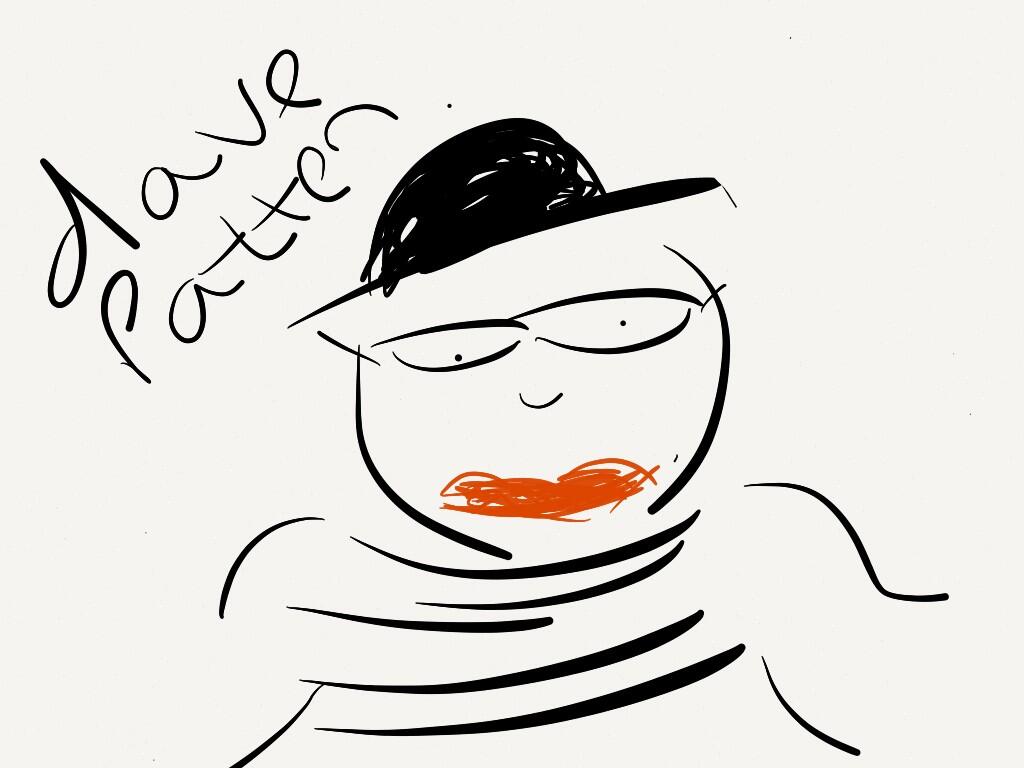
hand drawn Dave Patten
Museums and the Web 2013: Rewiring, Games and Computer Club
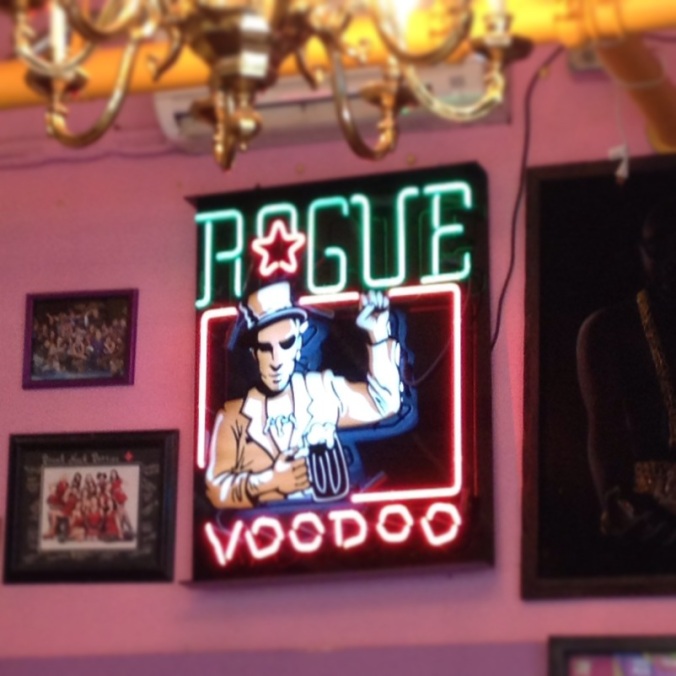 Museums and the Web was a bit of a blur and over a month later I haven’t really managed to process any of it. I’m also recovering from over indulging in Voodoo Donuts.
Museums and the Web was a bit of a blur and over a month later I haven’t really managed to process any of it. I’m also recovering from over indulging in Voodoo Donuts.
I was speaking in the Rewiring the Museum, Part of the “Innovating the Museum” session thread with 2 other pretty nifty papers.
- In line, Online: Curator buy-in starting from the ground up – Eric Espig, Canada, Alyssa McLeod, from the Royal BC Museum, Victoria, Canada
- This is Our Playground: Recognising the value of students as innovators – Oonagh Murphy, Northern Ireland, Alan Hook, from the University of Ulster, Northern Ireland
I was speaking with Carolyn Royston (IWM) about the Positives and Negatives of R&D in museums and the lessons we have learnt from the Social Interpretation Project. You can check out our paper titled ‘Visitors, Digital Innovation and a Squander Bug: Reflections on Digital R&D for Audience Engagement and Institutional Impact’
There were a massive selection of sessions, a couple of my favourites were the ‘Let the Games Begin‘ or the Gamification smackdown session. the debate kicked off as soon as the panellists started speaking. Sharna Jackson from Tate Kids was simply awesome on the naffness of badges for just rocking up to a museum. Visitors should be challenged before they are rewarded. Loved it.
I also really enjoyed the excellent Professional Forum: Digital Strategy from Europe to the US which had 4 great speakers discussing the highs and lows of digital strategy.
- Kajsa Hartig (Nordiska museet) talked about:Communicating the Museum: From Digital Strategy to Plan of Action – Two Years Down the Road
- Sarah Hromack (Whitney Museum of American Art) told us about: Utopia Then, Reality Now: (Re)considering the Wiki Model in Museum Culture
- Carolyn Royston (IWM) focused on Destination Success: Sustaining your digital strategy but really it was about initiating a Computer Club (with Stickers) within IWM Take the bull by the horns and make changes internally before expecting the public to understand. This created a real buss during the session, it will be great to hear if that buzz is replicated inside the museum when it launches. I really do want me an expert sticker.
- John Stack (Tate) talked about embedding digital in everything the museum does. Tate Digital Strategy: Digital as a dimension of everything
They also launched a pretty nifty Institutional Strategy Digest zine.
Here are my top 3 tweets of the conference:
Danny Birchall @dannybirchall: “I want to make people uncomfortable, I want to make games about genocide” -@museumpaige #mw2013 11:27 PM – 19 Apr 13
Wil Arndt @warndt:Museums need to install a bar in every exhibit. Funding problem solved. #MW2013 11:43 PM – 20 Apr 13
sebchan @sebchan:Love that @caro_ft is setting up the Imperial War Museum’s Computer Club! Pocket protector awesomeness! #MW2013 12:28 AM – 20 Apr 13
Blimey, Day of DH nearly passed me by!
It was the Day of DH yesterday, where Digital Humanists all over the world are telling people what they are up to on a specific day. Its a great opportunity to see what the DH community are up to. I have taken part every year since I joined UCLDH. Here are my posts from 2010, 2011, and 2012
However this year has been a bit different.
This is reposting of the blog post I’ve put up on the Day of DH 2013 site:
It’s normally quite quiet at this time of year, the Easter holidays always arrives at just the right time, when everyone really needs a bit of a break. So there hasn’t been as much email as normal. which is good because I’m supposed to be focused on one very important document…
I have been working at home, away from the office and the distractions, on my PhD research. I’m in write up stage. Less than a year to go, and I’m piling on the pressure to get it done. I’m trying to keep all distractions to a minimum, and the aim is to churn out at least 1000 words a day, every day, until I have a full first draft. But shutting myself in the study with only herbal tea to keep me company is actually quite difficult to do and challenges everything that is quite DHy about me.
My PhD in Digital Humanities has seemingly made me less Digital Humanities in real life. I used to blog, tweet, email, collaborate and tinker regularly. Now I don’t really do anything except write, and procrastinate.
I managed 2189 words yesterday. But Day of DH passed me by, I only realised this morning that it was yesterday. Does that mean DH isn’t on my radar any more? will I get it back when I eventually finish my PhD? I hope so.
Bits2Blogs: Flip-Flops, Crapjects, Playful learning and leaving the phone at home
This week I had the pleasure of being back up in my home town for the Bits 2 Blogs conference. Bits2Blogs is an annual event for anyone working in the North East cultural heritage sector, it was great to see and hear a regional spin on new ideas and new technologies to engage audiences. Particularly in a region which is dealing with horrible governmental cuts to arts and culture. The focus on best practice on innovative digital projects saw topics range from some pretty nifty mobile apps, through to vanishing soundscapes and creating meaning from archives processes. And to add some extra sparkle there was the addition of Flip-Flopping and Crapjects. What more could you want in a conference!? Here’s the condensed version of my notes.
Leave the Phone at Home!
Jason daPonte is a brilliantly inspiring speaker. Fact. He’s very good at highlighting the point that staring at a mobile phone screen instead of the surrounding environment is unnatural. You should always use the device that comes most naturally to the interaction. This is not mobile phones. We all seem to be obsessed with mobile applications, mobile web experiences. But really what is awesome is standing in front of the object in the gallery. Jason’s talk really reminded me of something Bruce Wyman said at MW2012 “Design for verbs” design experiences for specific interactions you want people to have. Because the value of the interaction is critically important. Jason talked about
Jason discussed the ways museums need to consider the futures relating to mobile media. Or lack of future , instead focusing on subphones where he underlying phone functionality is embedded in other things, and the silent conversations of the Internet of Things. So forget unnatural interactions on your phone, and start thinking about playing tag with hoodies (check out Neighbourhoodie);or embedding the ability for the oyster card to refund you if you are more than 15minutes late on the tube; or even Clothes hangers in C&A which tells shoppers how many people have liked the item of clothing on Facebook.
Jason hit home that working across platforms won’t be about web, mobile and tv. It will be about delivering contextual content and services in the most relevant places for users. Competition for attention will be via ambient media.
Three key points:
- Designing visibility
- Make things simple and just work
- Gather data and create meaning out of it.
Representing Sound Visually
Ian Rawes from London Sound Survey talked about vanished soundscapes and the importance of presented sound data well. Just because you’ve got good sound recordings on your website doesn’t mean your site visitors will necessarily listen to them. While a good content description is essential for sound archivists (check out the fab Content summaries BL sound and moving image catalogue) they’re not particularly attractive to the casual listener so how about creating some sound maps (look at BL UK sound map) and invest time in getting people browsing sounds, something like how BBC Radio provides journalistic teasers, photos and other extras on their pages.
Starting Somewhere and making smaller, faster changes
Andrew Lewis, from the V&A reflected on the development of the V&A’s digital strategy over the last 18 months and the realities of implementing change. I really enjoyed Andrew’s talk, I do love me a bit of institutional change chat. the V&A has attempted to not be a ‘giant ship that’s hard to turn’ and adapt to the changing needs relating to digital. Andrew talked about how the V&A doesn’t want to be a giant ship with lots of little (organisational) silos that’s hard to turn but an institution which can adapt to the changing needs relating to digital. He presented a list of key themes to think about when working with digital strategy’s and making change happen:
- Be audience focused
- Use open data driven as default
- Mobile first
- Use shot planning cycles and defined product lifespans
- Make faster, smaller changes
- Be prepared for some Tough Love: Change requires hard decisions and effort
Andrew’s slides are already up on slideshare
What on earth is Flip-Flopping?
Dominic Smith from the Tyneside Cinema did a brilliant presentation. With some excellent terminology.
The flip-flop is a term from the writer Robin Sloan and defined as: ” the flip-flop (n.) the process of pushing a work of art or craft from the physical world to the digital world and back again—maybe more than once.”
Dominic used the example of 3D printing to get his point across. Museum have been digitising physical objects for some time both in 2d and 3d. But now that 3D printing is becoming more accessible museums have the potential to re-materialise these digital objects in interesting ways, and avoid creating ‘crapjects’ (rejects and misprints from 3D printing). Greg Petchovsky’s work focusing on mixing digital sculptures with real objects is a great example (see cracking video above).
But what does this mean for authenticity, value and Walter Benjamin’s aura? As media becomes increasingly transient from physical to digital and back again does its meaning change? Is the meaning lost?
Dominic then went on to discuss starting to see a marketplace for 3D objects, but if there is a market there’s a potential for pirating. Is this a bad thing? Really? Museums have a tendency to turn a bit Gollum like and not let go of the ‘precious’ objects with a fear of something like fake Disneyland. What does it really mean when visitors can scan a perfect copy of your objects on their phone? How can museums make this work in their favour?
Compelling Objects
Rachel Clarke from Culture lab talked about exploring the qualities of digital representation through sensory & aesthetic experiences of objects. Two of the projects Rachel discussed really stood out for me:
- The Whispering Table, a gorgeous installation where the technology wasn’t retrofitted onto the objects, instead the objects were carefully designed around the technology.
- and a project dealing with Personhood and dementia- reminiscence, reflection and celebration by Jayne Wallace
Ultimately Rachel hit home that Digital processes change how we engage with objects and we need to think a bit more about what this means and the impact this has on our relationship to/with objects.
Playful Learning
Ben Templeton, from Thought Den talked about the creative process and the practicalities of three pretty awesome digital projects which all focus on playful learning: Wildscreen Arkive’s Survival app, Tate’s Magic Tate Ball, and Bristol Zoo’s Zoom.
Some key points in my scribbly notes:
- Content is king: Think long an hard about what the stories are. If you are asking visitors to unlock content its important to unlock good content. Unlocking needs to have an adequate reward. Magic Tate Ball is brilliant because it focuses on stories, the contextual awareness. The human angle of interpretation is key, but this can take time and effort. Be prepared.
- Test everything with users! User Testing is always talked about and advocated for but actually rarely done in practice. Why? It can be done cheaply and quickly, and even a little bit of testing is better than none at all.
- Simplicity is the way forward.
- Design in order to take the visitor/user on a journey
- Making a fuss come launch day is a really good idea. And Launch isn’t just the day it goes live, it has a long tail. It is worth the effort.
Thanks to John Coburn and the Great North Museum for being excellent hosts! Lots of inspirational ideas to take away ponder and action points to implement!
Can museums place an automatic value on their visitor generated content?

Image from http://www.artquest.org.uk/valueadded/
A quick ponder into visitor generated content and value classification.
Twitter has introduced new metadata for tweets; with the objective of helping developers filter out the most “valuable” tweets. This immediately got me thinking about visitor generated content (VGC) in museums. My PhD is grappling with the idea of impact and how you can go about measuring impact of VGC on museum experience. Over the past couple of years working on QRator and the Social Interpretation project, it has become clear that VGC, impact and value are notoriously difficult to define, interpret and well basically study.
In essence, Twitter is going to be introducing new metadata for Tweets so that you will receive tweets tagged up with value levels; initially just no value, low and medium. No High value tweets just yet. The aim is to make it easier for developers to surface what is arguably the better and more interesting content from otherwise noisy or high volume tweet streams.
We had a similar problem with the Social Interpretation VGC in particular, a high volume of visitor comments, and no clear way of moderating, categorising or “valuing” the better quality visitor comments. As with most high volume unstructured data, finding and highlighting the signal out of the noise can represent a significant challenge.
The problem is that “value” is highly subjective and varies on the context within which it is being consumed. One visitor’s value is not the same as the next. Nor is it likely to match what the museum defines as adding value. The SI team at IWM experimented with gardening comments, but we didn’t come up with a criterion to work from, so it was up to the moderator at the time to decide. At the Grant Museum with QRator we are trying to come up with criteria to look at the visitor answers to the current questions, but this is after the point of visitor contribution, and is very much based on the museum’s perceived value of the response. Is value something you add in the post moderation stage? Who’s value? The visitors or the museums?
So, is Twitter’s new value algorithm something that can be used by museums to classify VGC?
If I’m honest, no I don’t think it is. Is it really possible to create an algorithm that can classify value of comments? Surely value is judged by the reader? Can an automated system really evaluate subjective factors and identify the most valuable conversations for each individual? Doubtful.
But I will be watching how Twitter deals with concepts of value of tweets with interest.
Notes on Ross Parry’s Presentation: The end of the beginning: Normativity in the postdigital museum
Final set of Notes from ‘The Shape of Things: New and emerging technology-enabled models of participation through VGC’ conference at Leicester’s school of Museum Studies, part of the AHRC-funded iSay project focusing on Visitor-Generated Content (VGC) in cultural heritage institutions. Ross’s talks always inspire and make me feel very insignificant in terms of theory in equal measure.
Ross Parry: The end of the beginning: Normativity in the postdigital museum
- Based on new research into how 6 UK national museums
- Are 6 national museums showing a national trend? Or just highlighting that those with money can play more?
- naturalise ‘digital’ into their overall museum vision
- Digital being naturalised within the museum…
- 1980 paisley institute fox communication research- the museum in 1980
- Connected museum
- Normative
- The duality of technology rethinking the concept of tech in organisations
- Wanda Orlikowski – dynamic relations between information technologies and organizations over time
- Has digital in museums become normative?
- Structures of domination, structures of legitimisation, structures of signification.
- Digital as a recurring motif
- Digital being naturalised within the Museums vision and articulation of itself – once limited information on digital, forced to highlight ‘digital’ in strategies, organisational structures and projects has evolved to being incporated throughout.
- A preparedness for a post digital org structure
- Actively recruiting blended roles
- The presence of digital thinking
- Digital being part of the generative and ideation moment
- Blended production
- Strategising for a multiplatform future
- No need for digital to be strategised separately.
- post-digital museum is one where digital technology has become transparent: it has become so permeated into everyday activities that we no longer reflect upon or feel challenged by its digital character. Personally I don’t think this is true in the practical and operational issues of museums. It might resonate in Digital departments, but not throughout the whole of the museum.
- What does post digital stance have for how we situate research?


